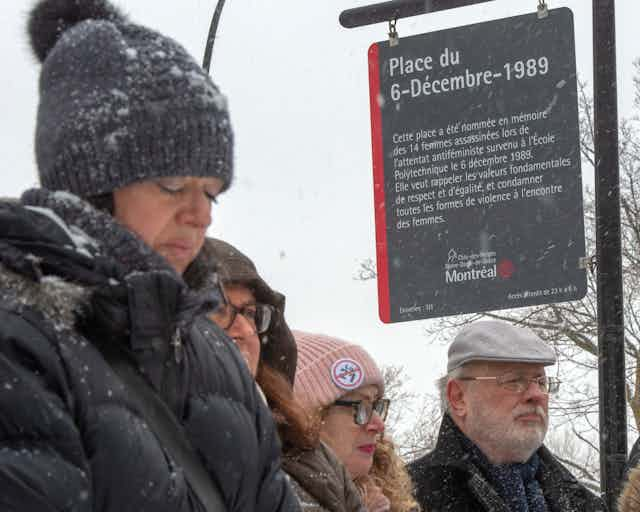In the late afternoon of Dec. 6, 1989, a gunman arrived at the École Polytechnique in Montréal armed with a semi-automatic assault rifle and hatred in his heart.
The 25-year-old made his way into a classroom, ordering the men out. Alone with the remaining nine female students, he declared his hatred for feminists before spraying them with bullets, killing six of them instantly. The others, wounded, played dead until he left the room.
He then moved methodically through the halls and cafeteria of the l’Université de Montréal’s engineering school, shooting more women, cutting some down as they ran for their lives, until he came to a second-floor classroom where he killed more as he ranted. He turned his gun on himself after he stabbed his last victim.
By the time police intervened, it was too late. The 20-minute rampage left 14 women dead, including 13 students and an administrative assistant. They were Geneviève Bergeron, Hélène Colgan, Nathalie Croteau, Barbara Daigneault, Anne-Marie Edward, Maud Haviernick, Maryse Laganière, Maryse Leclair, Anne-Marie Lemay, Sonia Pelletier, Michèle Richard, Annie St-Arneault, Annie Turcotte and Barbara Klucznik-Widajewicz.
It is to this day the deadliest mass shooting in Canadian history.
Thirty years later, young men are still killing women and planning mass attacks, this time on the pretext of being deprived of sex. These “involuntary celibates” (incels) are celebrated on social media — the place where calls for the murder and rape of women, as well as racist statements, intersect.
Alek Minassian, accused of using a van to kill 10 people — most of them women — in a driving rampage in Toronto in April 2018, was hailed by members of the so-called incel movement as one of their own.
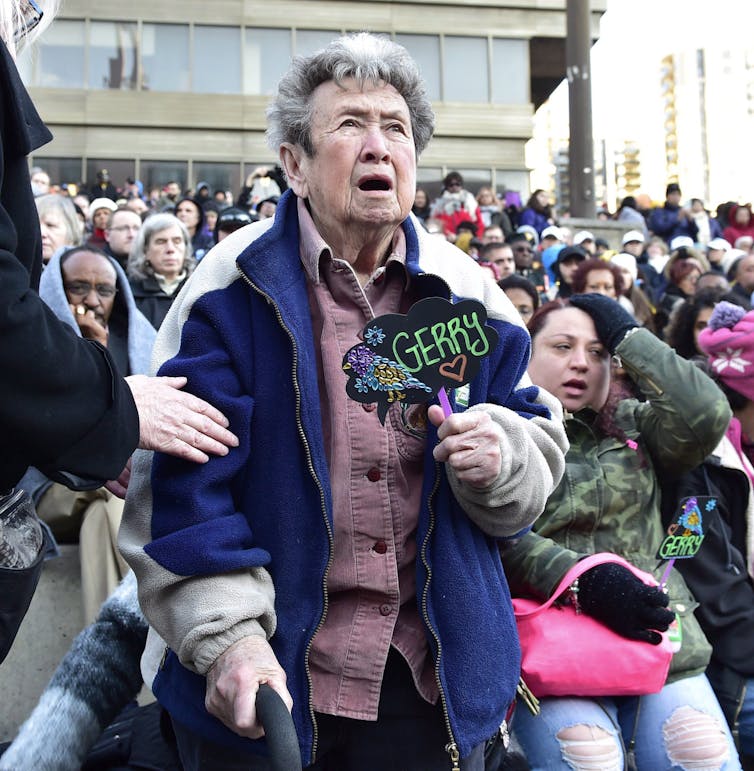
The Montréal shooter targeted women who were destined for a non-traditional occupation, claiming that they were taking over from men. These new terrorists want to punish and terrorize women because they would deny them sex to which they claim to be entitled. All these mass murders ultimately constitute terrorism against women and feminists.
But it took 30 years to dare to use these terms outside feminist circles to describe and analyze the Montréal Massacre. Indeed, the City of Montréal has just recognized it as an “anti-feminist act.”
Battle of interpretations
On the evening of the attack, Radio-Canada, the French-language network of the CBC, described the shooter as a “mad killer.” But the ugly anti-feminist sentiments we hear so often today were also present then. Some men called into radio talk shows and said they understood the killer’s motives and wanted to imitate him.
Feminists, on the other hand, organized a candlelight march. The following week, crowds filed past 13 caskets displayed in the Hall of Honour of the Université de Montréal to pay their respects. (One family opted for private ceremonies.) Corridor walls were covered with fax messages from schools and engineering firms from around the world expressing their condolences.
A mass funeral was then held at Notre-Dame Basilica in Montréal, despite voices denouncing this being done in a Roman Catholic Church, an institution controlled by men.
From the very first days, there was a struggle to determine how to explain the attack, already described as “historic” by many journalists. Was the killer simply insane or misogynistic?
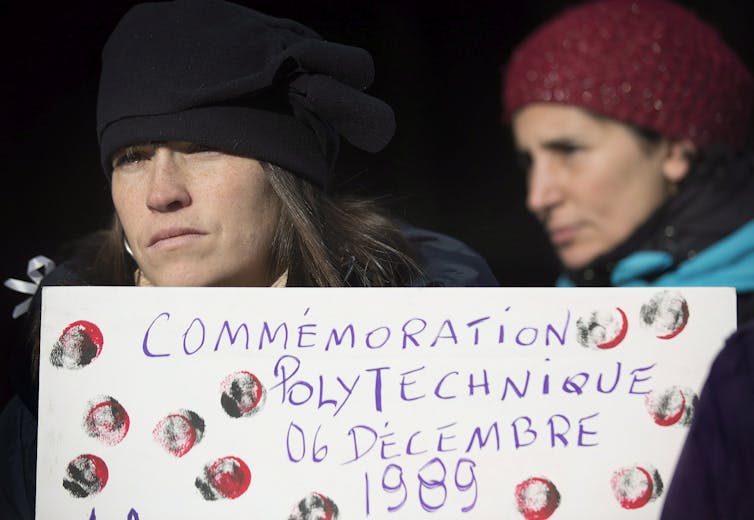
A study of three daily newspapers, covering the years 1989-90, 1999-2000 and 2009, made it possible to distinguish several versions of recollections that complement or confront each other.
Feminists argued it was a misogynistic crime because the killer targeted female engineering students. Some pro-feminist men called for self-criticism. Other people blamed the attack on television violence or the way in which police responded. (Police intervention protocols would subsequently be revised, as seen in future mass shootings such as the one at Dawson College in 2006.)
A pressure group that included survivors of the Montréal Massacre and relatives of victims also called for a ban on the type of firearm used by the killer while demanding tighter gun control. The federal Liberal government created a firearms registry in 1995, although the Conservative government of then prime minister Stephen Harper would abolish it in 2012.
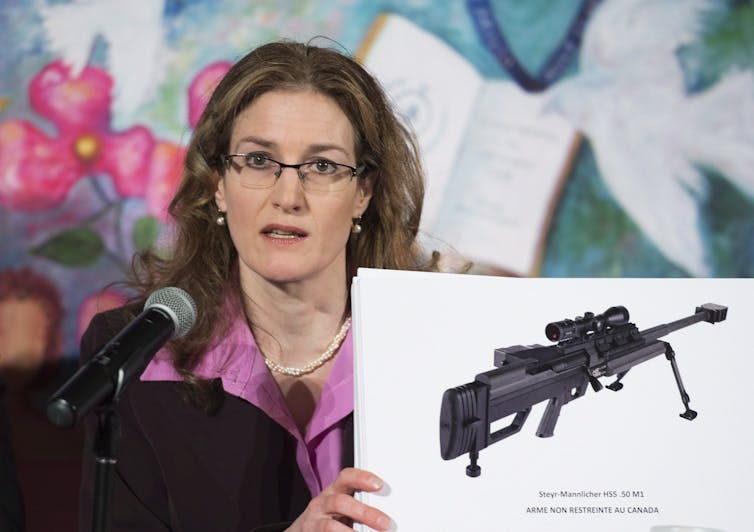
Read more: A short history of the AR-15 in Canada
As well, the massacre also seemed to stimulate the expression of a virulent anti-feminism, with Catholics even asking women to stay silent out of respect for the victims’ relatives.
Meanwhile, some psychologists claimed the Montréal shooter was suffering from personality disorders — despite never having diagnosed the killer or viewed his medical file. The decision to psychologize the murder was to depoliticize the massacre.
(A similar process happened after the January 2017 attack at the Québec City mosque where six Muslim men were murdered. Here too, the victims’ voices were reduced to their suffering alone, while their experiences with racism and Islamophobia was often ignored in favour of expertise developed at the expense of those most affected.)
Other people, including psychologist Guy Corneau, claimed the École Polytechnique massacre was the consequence of the “absent father” and the expression of a “masculinity crisis.”
Some media also incorrectly reported that École Polytechnique had rejected the shooter’s application to attend the school. (At that time, less than 20 per cent of the students were women.)
Eleven months after the murder, journalist Francine Pelletier received a copy of a suicide letter written by the killer found on his body. He explained his political motivations and listed 18 women (and a group of anti-sexist men) he wanted to kill, including feminist figures, as well as the first female police officer, the first woman firefighter, and others.
Pelletier herself was also named. Describing himself as a “rational scholar,” the killer had even anticipated that he would be called a “mad killer,” even though he was very clearly expressing his political motivations.
Finally, members of an anti-feminist “masculinist” movement even accused feminists of capitalizing on the attack. Some individuals even identified themselves with the killer, for example in threats to women and saying it was a normal male reaction after so many advances by women through feminism.
This reference to the killer is still found today in several cyberattacks, for example against women working at l'Université du Québec à Montréal (UQAM). An openly anti-feminist website has even been dedicated to the killer, described as a “hero and martyr.”
Terrorism
In December 2009, feminists proposed that the 1989 massacre be considered an anti-feminist “terrorist attack,” since the killer was not only targeting female students directly, but also seeking to ultimately terrorize all feminists.
Yet it took 10 years before the City of Montréal officially recognized it in those terms, in particular changing the wording on the commemorative plaque at the Place du 6-décembre-1989 memorial park to say the women were murdered in an anti-feminist attack.
As part of the commemorations of the 30th anniversary of the Montréal Massacre, feminists have renewed the analyses of this institutional and epistemic violence, which particularly affects racialized women.
At UQAM the commemoration of the anniversary included the event “Remembering to Act,” featuring an international symposium, a play by Pol Pelletier, a music show, an art exhibition by the Guerrilla Girls, a thematic exhibition and a gathering organized by the Fédération des femmes du Québec (see the DVD of the book Retour sur un attentat antiféministe.)
In 2014, the 25th commemoration saw a major ceremony attended by many dignitaries and the beginning of a moving tradition. The Moment Factory collective created a work of light composed of 14 beams rising above the Mount Royal lookout and each Dec. 6 since, that has continued.
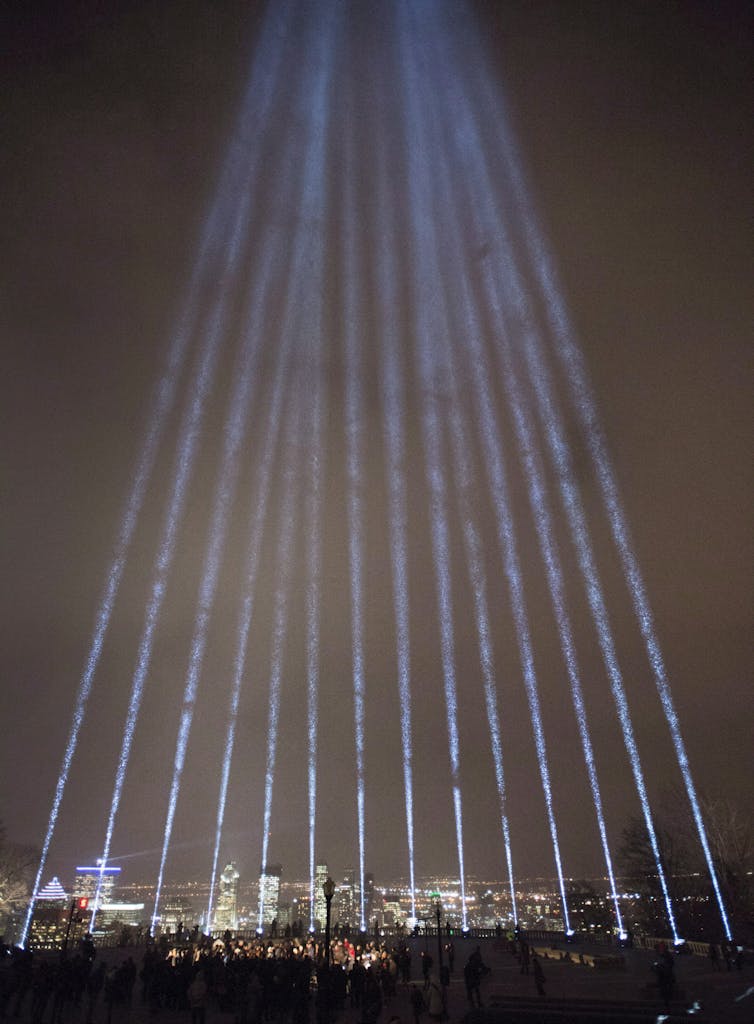
As we have seen, the struggle to understand the Dec. 6, 1989, tragedy continues over the decades, but the increasing distance seems to allow feminists to be better heard in the public space.
Thirty years later, several commemorative events were organized locally and across the country to keep alive the memory of the 14 women killed. Thanks to the Réseau québécois en études féministes, UQAM, the Université de Montréal and Université Laval that have joined community groups (including the R des centres de femmes and the Comité 12 jour d'action contre la violence envers les femmes to examine, but also denounce, anti-feminist attacks and various expressions of violence against women.
In short, the scale of these commemorations reveals feminists’ determination to put an end to violence against women in all its forms.
At a time like this, however, when we are obsessed with terrorism, it still seems difficult to consider the importance of the anti-feminist hatred that is spreading on the Internet, even if it is part of an anti-feminist logic promoted by the Montréal Massacre killer.
[ You’re smart and curious about the world. So are The Conversation’s authors and editors. You can read us daily by subscribing to our newsletter. ]

